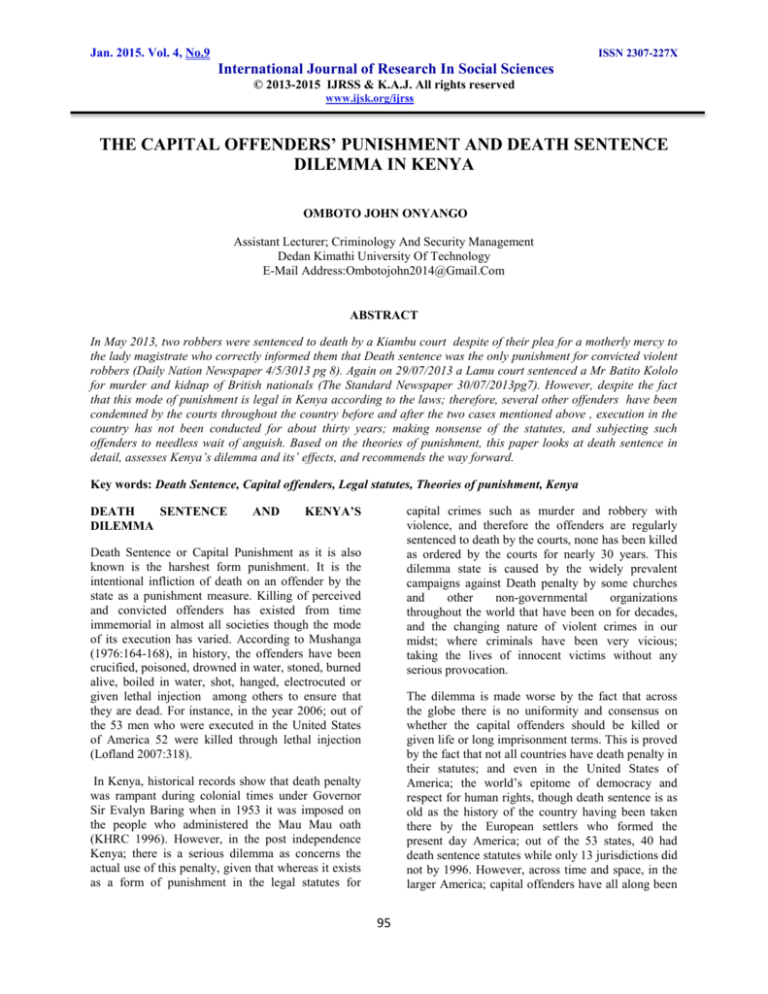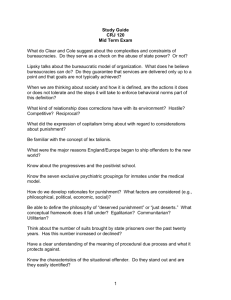
Jan. 2015. Vol. 4, No.9
ISSN 2307-227X
International Journal of Research In Social Sciences
© 2013-2015 IJRSS & K.A.J. All rights reserved
www.ijsk.org/ijrss
THE CAPITAL OFFENDERS’ PUNISHMENT AND DEATH SENTENCE
DILEMMA IN KENYA
OMBOTO JOHN ONYANGO
Assistant Lecturer; Criminology And Security Management
Dedan Kimathi University Of Technology
E-Mail Address:Ombotojohn2014@Gmail.Com
ABSTRACT
In May 2013, two robbers were sentenced to death by a Kiambu court despite of their plea for a motherly mercy to
the lady magistrate who correctly informed them that Death sentence was the only punishment for convicted violent
robbers (Daily Nation Newspaper 4/5/3013 pg 8). Again on 29/07/2013 a Lamu court sentenced a Mr Batito Kololo
for murder and kidnap of British nationals (The Standard Newspaper 30/07/2013pg7). However, despite the fact
that this mode of punishment is legal in Kenya according to the laws; therefore, several other offenders have been
condemned by the courts throughout the country before and after the two cases mentioned above , execution in the
country has not been conducted for about thirty years; making nonsense of the statutes, and subjecting such
offenders to needless wait of anguish. Based on the theories of punishment, this paper looks at death sentence in
detail, assesses Kenya’s dilemma and its’ effects, and recommends the way forward.
Key words: Death Sentence, Capital offenders, Legal statutes, Theories of punishment, Kenya
DEATH
SENTENCE
DILEMMA
AND
KENYA’S
capital crimes such as murder and robbery with
violence, and therefore the offenders are regularly
sentenced to death by the courts, none has been killed
as ordered by the courts for nearly 30 years. This
dilemma state is caused by the widely prevalent
campaigns against Death penalty by some churches
and
other
non-governmental
organizations
throughout the world that have been on for decades,
and the changing nature of violent crimes in our
midst; where criminals have been very vicious;
taking the lives of innocent victims without any
serious provocation.
Death Sentence or Capital Punishment as it is also
known is the harshest form punishment. It is the
intentional infliction of death on an offender by the
state as a punishment measure. Killing of perceived
and convicted offenders has existed from time
immemorial in almost all societies though the mode
of its execution has varied. According to Mushanga
(1976:164-168), in history, the offenders have been
crucified, poisoned, drowned in water, stoned, burned
alive, boiled in water, shot, hanged, electrocuted or
given lethal injection among others to ensure that
they are dead. For instance, in the year 2006; out of
the 53 men who were executed in the United States
of America 52 were killed through lethal injection
(Lofland 2007:318).
The dilemma is made worse by the fact that across
the globe there is no uniformity and consensus on
whether the capital offenders should be killed or
given life or long imprisonment terms. This is proved
by the fact that not all countries have death penalty in
their statutes; and even in the United States of
America; the world‟s epitome of democracy and
respect for human rights, though death sentence is as
old as the history of the country having been taken
there by the European settlers who formed the
present day America; out of the 53 states, 40 had
death sentence statutes while only 13 jurisdictions did
not by 1996. However, across time and space, in the
larger America; capital offenders have all along been
In Kenya, historical records show that death penalty
was rampant during colonial times under Governor
Sir Evalyn Baring when in 1953 it was imposed on
the people who administered the Mau Mau oath
(KHRC 1996). However, in the post independence
Kenya; there is a serious dilemma as concerns the
actual use of this penalty, given that whereas it exists
as a form of punishment in the legal statutes for
95
Jan. 2015. Vol. 4, No.9
ISSN 2307-227X
International Journal of Research In Social Sciences
© 2013-2015 IJRSS & K.A.J. All rights reserved
www.ijsk.org/ijrss
killed by the state, with the first lawful conviction
and execution being that of Captain George Kendall
who was killed for being a spy of Spain in 1608
(Bohm and Haley 1996:239-299). Since Kendall‟s
execution; thousands of executions have taken place
in America, with the first woman to die in electric
chair executed in 1899 at Newyork‟s Sing Sing
Prison (Lofland 2007:326).
offender to commit further crime. The desire to
incapacitate an offender is normally achieved by
removing the offender from the society. This can be
through imprisonment where his or her freedom will
be restricted as a prisoner, or by death sentence. The
goal of reformation and rehabilitation is to change the
character and personality of the offenders, and to
make them fit back into the society as law abiding
citizens.
Kenya‟s unique position on death sentence is made
clear by the fact that though for a long time it had
been guaranteed in the Kenyan constitution as per
sections 204, 40 (3), 296 (2), CAP 63, and the
Criminal Procedure Code CAP 75 (Tudor 1998:133) ;
it is hardly carried out. Therefore, several prisoners
whose appeals failed in all stages of the courts
continue to wait in anguish for the hangman who
never comes. For example, in June 2003, 28 death
row inmates in this category; most of whom had
spent between 15 and 22 years waiting to be hanged
were given clemency by the president. Those who
were hanged in Kenya last were the 1982 coup
plotters; thereafter, the then head of State – Daniel
Toroitich Arap Moi never signed any more death
warrants up to the time of his retirement in 2002, just
as his successor Mwai Kibaki. The constitution
promulgated in August 2010, does not help our
dilemma state as it does not expressly allow or
disallow death penalty. For instance Article 26(1)
states that “every person has a right to life”, this is
not consistent with Article 26 (3) which states that a
person can be deprived of life when authorised by the
constitution or written law.
THE THEORETICAL
SUPPORT OF, AND
PENALTY
On the other hand, the retribution theory of
punishment is based on the desire to revenge against
the offender for his or her criminal activities. It is
“an eye for an eye” and “a tooth for a tooth” driven.
Based on this theory; when judges pass their
sentences, it is believed or expected that they should
award sentences commensurable to the severity of the
offence.
In the case of Death sentence as a punishment; two of
the above theories mainly apply in its‟ support. The
first is retribution; for instance, convicts of heinous
crimes are sentenced to death to fulfil our human
desire for vindictive revenge. That is, death sentence
is seen to be the only proportionate punishment to the
crime committed particularly where life has been
lost. It is based on the feeling that the offenders who
have taken the life of other human beings must also
not be allowed to live. Can this explain why in
Kenya, where death sentence though legal but has not
been practised for nearly 30 years; the public easily
lynch suspected criminals?
Death sentence has also been supported because of
its incapacitating power; its‟ ability to stop the
offender once and for all from committing more
crimes since when the convict is killed as ordered by
the courts, he or she will never come back again to
bother the society. This is unlike in the case of
imprisonment where such vicious offenders will one
day be released, and in case such offenders are
imprisonment for life; again, there is a chance that
they will still get back into the society due to a
possibility of a pardon; in Kenya, this is guided by
the Power of Mercy Act of 2011.
ARGUMENTS IN
AGAINST DEATH
Any punishment awarded by the courts be it
imprisonment, fines, community service order,
probation service, and death sentence is theoretically
expected to deter, incapacitate, and or reform and
rehabilitate the convicts. The punishments also serve
as a retribution measure (Tewkbury (1997:111),
Birzer et.al, (2004:36), and Laufer et.al, (1996:275).
The deterrence theory of punishment posits that any
punishment awarded to an offender should make him
or her, and others who witness the punishment to
avoid committing crime again after being punished
based on fear. The former is referred to as specific
deterrence while the latter is a general deterrence.
The incapacitation theory of punishment portend that
a punishment must make it impossible for an
It is also argued that death sentence has a symbolic
value of power for the law enforcement officials who
arrest and prosecute the capital offenders; thus in its‟
absence,
extra-judicial
executions
by
law
enforcement officers become rampant because they
may, in frustration feel that the capital offenders
when arrested and presented in courts of law will „not
be adequately punished‟. It is therefore prudent for
96
Jan. 2015. Vol. 4, No.9
ISSN 2307-227X
International Journal of Research In Social Sciences
© 2013-2015 IJRSS & K.A.J. All rights reserved
www.ijsk.org/ijrss
the Kenyan government to establish the veracity of
the ex-judicial killings by the police as have been
reported in the media of late, and also documented in
the year 2007 by Prof. Philip Aston; the United
Nations special rapporteur on extrajudicial killings. If
the reports are correct, the government must further
seek to find out the extent to which the killings can
be attributed to the fact that Kenya had long
suspended death penalty.
However, despite the opposing voices; the
ruthlessness of the present day criminals and the
escalating rate of violent crimes in Kenya make some
people; in frustration, to demand a more severe
punishment for the offenders. This frustration was
best echoed by the then KANU MP for Ntonyiri –
Maoka Maore who, infuriated by the calls to abolish
death sentence bitterly said in parliament on the
convicts on death row: “We should hang them with a
high density rope until they go to their ancestors. In
this way, we will have a safe and peaceful
society”1That kind of support for death sentence is
despite the fact that even though it has been
guaranteed in the Kenyan laws from independence; it
has not been carried out in decades, which has made
several convicts whose appeals fail in all stages of
the courts to wait in anguish for as long as 20 years
for the hangman who never comes.
Opposition to death sentence is based on the theory
that it does not offer the vital specific deterrence, and
do not rehabilitate the offender. Punishment, it is
argued, should make the offender in question fear to
commit crime in future, and or offer the offender a
chance to be reformed and rehabilitated. In death
sentence both of these cannot be achieved. Those
who oppose death sentence have also argued that in
most cases, it is normally awarded to the
economically and socially weak offenders and not to
the powerful individuals. Those who belong to this
school of thought posit that it is the poor ignorant
masses who cannot always afford the cost of legal
redress who are normally sentenced to death. The
severity of the sentence vis- a-vis the possible
execution in error, where the convict is actually
innocent, has also led to strong opposition to the
death penalty. An example of such execution in error
was that of United States of America‟s James
Adams of Florida State who was proved innocent
after his execution in 1984 (Bohm and Haley 1996 :
301).
In most cases such waiting only ends with the
clemency of the president that commutes such
sentence to life; and latter release of such offenders
back into the society. Therefore to relive offenders
from such anguish and uncertainty, if Kenya
continues to maintain death sentence in its‟ statutes
as is the case; then there is an urgent need to specify
in the law the duration of time a convicted death row
offender should take to be executed from the date of
the final court sentence after all the appeals have
failed; currently this is not the case. It is also possible
that the failure to execute the convicted death row
offenders in Kenya has been occasioned by the fact
that a president as an individual may be reluctant to
„dirty‟ his or her hands by being the final individual
who must decide and sign the execution warrant to
authorise the killings. This paper suggest that the
current and former Kenyan presidents‟ opinions
should be sort on this matter; an if this is the case,
and as a country we decide to maintain this form of
punishment in our laws, then this burden of signing
the execution orders should be removed from the
presidents‟ shoulders as an individual to the group
of Supreme Court judges, and the Attorney General
of the republic.
It has also been reasoned that when an offender is
put to death, the real sufferers are his or her
dependants such as a spouse, children, and parents
among others, who never committed the crime. Such
individuals may suffer great psychological anguish,
social and economic loss; more so if the convict was
a bread winner to the family, and the other
dependants. However, in support for, and opposition
of death sentence; God‟s position is mentioned by
both sides. For instance; the bible‟s ten
commandments‟ “Do not kill”, the death sentence
abolitionists say, means God is against any kind of
killing; be it of those who have committed heinous
crimes such as murder, while the pro death sentence
normally relies on verses such as Exodus 21:12
“anyone who strikes a man and kills him shall surely
be put to death” to justify death sentence for
convicted murderers.
REFERENCES
1.
2.
EXEMPT THE PRESIDENT, AND SPECIFY
THE DURATION TO EXECUTION
3.
97
Birzer M L et.al, (2004:36) Introduction to
Corrections, Copper House- Publishing
Company.
Bohm R.M. and Haley, K N
(1996)
Introduction to Criminal Justice, Glenncoe,
Mc Graw Hill. New York.
KHRC- Kenya Human right Commission
Jan. 2015. Vol. 4, No.9
ISSN 2307-227X
International Journal of Research In Social Sciences
© 2013-2015 IJRSS & K.A.J. All rights reserved
www.ijsk.org/ijrss
4.
5.
6.
7.
8.
9.
(1996) A death sentence - Foundation Press.
Nairobi.
Laufer Williams.et.al (1996) Criminal
Justice the core, McGraw Hill company
New York –USA
Lofland (2007) Police procedure and
investigation; A guide for writers.-Writer‟s
Digest Books Cincinnati, Ohio.
Mushanga T. M. (1976) Crime and
Deviance: An Introduction to Criminology
Nairobi Kenya literature Bureau.
Tewkbury R.A (1997) Introduction to
Corrections, McGraw Hill company-USA.
The Constitution of Kenya (2010)
Government Printing Press.
The Constitution of Kenya (Revised Edition
1970) Government of Kenya Printing Press.
10. The Criminal Procedure Code; Chapter 75
Laws of Kenya (Revised Edition 2009):
National Council Law Reporting.
11. The Holy Bible: New International Version.
East Brunswick: International Bible Society.
12. The Power of Mercy Act (2011) Government
of Kenya Printing Press.
13. Tudor .J (1998) The Law of Kenya 3rd
Edition, Kenya Literature Bureau-Nairobi.
Foot Note
1.
Sunday Nation Newspaper of 11/4/2004 Pg 15
A woman kicks a suspected conman arrested in Nakuru-Kenya. Studies indicate that public lynching of
criminals become common where death penalty is not in place. (Picture from The Standard News papers).
98






